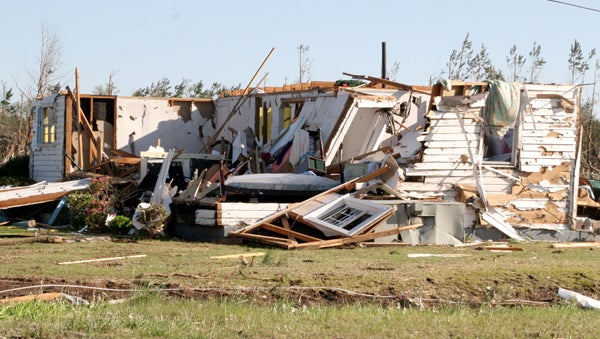Calm before the storm
Published 9:03 am Thursday, February 28, 2013

Severe weather can strike anywhere at any time, as evident in this photo taken on the morning after twin tornadoes cut a swath of death and destruction through Bertie and Hertford counties on April 16, 2011. This home was one of many that were damaged on Morris Ford Road near Colerain. File Photo by Cal Bryant
Spring is just around the corner, but with warmer weather comes the threat of severe weather.
Governor Pat McCrory has signed a proclamation declaring March 3-9 as Severe Weather Awareness Week in the state, cautioning North Carolinians to be on the lookout for tornadoes and severe thunderstorms as spring approaches. The proclamation recommends that families have safety plans for home, work or school so they can respond quickly when tornados or severe storms threaten.
Meanwhile, local Emergency Management officials are encouraging residents of the Roanoke-Chowan area to keep a close eye on the weather, especially during the spring months where cold fronts often collide with warm, moist air.
“We’ve seen how quickly these storms can strike and how dangerous they can be,” Governor McCrory said. “We’ve been lucky so far this year, but we can’t let our guard down. That is why it is so critical to have emergency plans in place.”
McCrory said county and state emergency managers are ready to respond to any disaster, but he cautioned that the first line of defense is at home and people should take time now to prepare. The governor urged North Carolinians to discuss and rehearse family emergency plans so that when the National Weather Service issues a storm warning in their area, everyone can act quickly and take shelter calmly.
Schools and government buildings statewide will hold tornado drills at 9:30 a.m. on Wednesday, March 6 to rehearse their emergency plans.
“Please take a moment to ensure you, your family, and your staff at your place of work are prepared for severe weather,” stated Brian Parnell, Coordinator of Northampton County Emergency Management. “Storms are so unpredictable, especially in the spring months where cold fronts are still present while warm fronts are gaining strength. When those two weather systems collide, enough unstable air is produced to spark moderate to severe thunderstorms, some of which will elevate to point to allow for the formation of tornadoes or straight-line winds that can cause serious damage as well.”
Chris Smith, Hertford County’s Emergency Management Director, said there’s no time like the present to have a plan in place in the event of severe weather.
“I press that issue every time I have an opportunity to speak to groups and organizations,” Smith said. “With Severe Weather Awareness Week coming up, that’s a great time to either put a plan together or practice the one you already have. I’ve found that some individuals and businesses have developed such a plan, but they do not take the time to put it to the test. I encourage them to do so next week.”
Smith added that his office and other emergency management officials throughout the state strive to quickly provide aid in the aftermath of a natural or man-made disaster. However, as is so often the case, local/state assistance sometimes takes days to assemble and carry out.
“If you are isolated by rising floodwaters and downed trees, then you need to understand that emergency responders are facing those same obstacles in an effort to get to you,” Smith noted. “Depending on the severity of those obstacles, it sometimes takes more than a day to remove them or get around them to provide disaster relief. That’s why having a plan of action in place is so important, not just for the actual weather event itself, but also for the hours or days in the aftermath of a storm.”
“We call that the 72-hour rule,” said Billy Winn, Gates County’s Emergency Management Director. “I would stress to families and businesses to be prepared for the first 72 hours after a storm. Put together and test a plan to carry you through those 72 hours. You may find yourself isolated and without electrical power. Have the necessities in place such as food, water, medicine, etc to get through that period of time.”
Winn stressed that local residents need to be prepared throughout the year.
“Even though we have this one week coming up set aside to draw attention to the threat of severe weather, we need to be prepared the other 51 weeks as well,” he stated. “I think a great lesson we all can learn is from our school systems. They constantly conduct emergency drills for tornadoes and fires. We can easily do that at home as well.”
In 2012, the National Weather Service issued 60 tornado warnings for North Carolina and recorded 21 tornadoes that injured 22 people. Combined, the tornadoes caused more than $19 million in damages. In addition, the NWS issued more than 1,050 severe thunderstorm warnings, and recorded more than 1,200 incidents of severe thunderstorms with damaging winds and/or large hail. The severe storms killed six people and injured 46 others.
March, May and November are the deadliest months for tornadoes in the state. However, residents should be equally prepared for other forms of severe weather, too, such as lightning, floods or hail.
Locally, those living in the Roanoke-Chowan region recall the deadliest day in history – April 16, 2011 – where 12 individuals were killed and millions of dollars in damage was incurred when two tornadoes tore through the Askewville and Colerain communities in Bertie County and also struck Hertford County in the Harrellsville area.
Tornadoes usually form during heavy thunderstorms when warm, moist air collides with cold air. These storms can also produce large hail and strong winds. Damaging winds are equally as dangerous.
Last year tornadoes damaged scores of homes and businesses in 19 counties, including Bladen, Burke, Cabarrus, Carteret, Caldwell, Cherokee, Columbus, Dare, Hyde, Jackson, Jones, Mecklenburg, Pasquotank, Richmond, Rutherford, Swain, Washington, Wake and Wilson.
North Carolina Emergency Management recommends people use the following safety tips:
During severe weather, listen to local radio, television, a weather channel or a National Oceanic and Atmospheric Administration radio for information.
Know the terms: WATCH means a tornado is possible. WARNING means a tornado has been spotted; take shelter immediately.
If at home or inside a residence, take shelter in a basement or the lowest floor of the house in an interior room such as a hallway, pantry or closet. Stay away from windows.
At a school, go to inner hallways, but stay out of gymnasiums, auditoriums or cafeterias where there is a large roof span.
In the office take shelter under something sturdy like a desk or a table to protect yourself from flying debris or a collapsed roof.
Mobile homes are especially vulnerable to high winds. Residents should go to a prearranged shelter when severe weather is predicted.
If on the road, drivers who see a tornado forming or approaching should leave the car immediately and take shelter in a low-lying area. Tornadoes can easily blow vehicles off a road and many people have been killed while trying to outrun a tornado.
On foot / bicycle: go to a safe place immediately to avoid falling trees, downed power lines or lightning. Inside a sturdy building is best. Lying flat in a ditch or low area may also offer protection, but beware of possible flash flooding and flying debris.
Preparation for any type of severe weather also means having a family disaster plan and an emergency supply kit assembled and in a location that is easy to access during an emergency. More information on tornadoes and overall emergency preparedness is available at www.ReadyNC.org and www.ncem.org.






